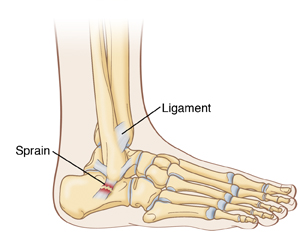An ankle sprain is a stretching or tearing of the ligaments that hold the ankle joint together. There are no broken bones.
An ankle sprain is a common injury for both children and adults. It happens when the ankle turns, twists, or rolls in an awkward way. This can be caused by a sports injury. Or it can happen from doing something as simple as stepping on an uneven surface.
Ligaments are made of tough connective tissue. Normally, ligaments stretch a certain amount and then go back to their normal place. A sprain happens when a ligament is forced to stretch more than the normal amount. A severe sprain can actually tear the ligaments. If you have a severe sprain, you may have felt or heard something like a pop when you were injured.
Ankle sprains are given a grade depending on whether they are mild, moderate, or severe:
-
Grade 1 sprain. A mild sprain with minor stretching and damage to the ligament.
-
Grade 2 sprain. A moderate sprain where the ligament is partly torn.
-
Grade 3 sprain. The most severe kind of sprain. The ligament is completely torn.
Most sprains take about 4 to 6 weeks to heal. A severe sprain can take several months to recover.
Your health care provider may order X-rays to be sure you don’t have a fracture, or broken bone.
The injured area will feel sore. Swelling and pain may make it hard to walk. You may need crutches if walking is painful. Or your provider may have you use a cast boot or air splint. This will depend on the grade of ankle sprain that you have.
Home care
-
For a Grade 1 sprain, use RICE (rest, ice, compression, and elevation):
-
Rest your ankle. Don’t walk on it.
-
Ice should be used right away to help control swelling. Place an ice pack over the injured area for 20 minutes. Do this every 3 to 6 hours for the first 24 to 48 hours. Keep using ice packs to ease pain and swelling as needed. To make an ice pack, put ice cubes in a plastic bag that seals at the top. Wrap the bag in a clean, thin towel or cloth. Never put ice or an ice pack directly on the skin. The ice pack can be put right on the cast, bandage, or splint. As the ice melts, be careful that the cast, bandage, or splint doesn’t get wet. If you have a boot, open it to apply an ice pack, unless told otherwise by your provider.
-
Compression devices help to control swelling. They also keep the ankle from moving and support your injured ankle. These devices include dressings, elastic bandages, and wraps.
-
Elevate, or raise, your ankle above the level of your heart when sitting or lying down. This is very important for the first 48 hours.
-
-
Follow the RICE guidelines for a Grade 2 sprain. This type of sprain will take longer to heal. Your health care provider may have you wear a splint, cast, or brace to keep your ankle from moving.
-
If you have a Grade 3 sprain, you are at risk for long-term ankle instability. In rare cases, surgery may be needed. Your provider may have you wear a short leg cast or a walking boot for 2 to 3 weeks.
-
After 48 hours, it may be helpful to apply heat for 20 minutes several times a day. You can do this with a heating pad or warm compress. Or you may want to go back and forth between using ice and heat. Never apply heat directly to the skin. Always wrap the heating pad or warm compress in a clean, thin towel or cloth.
-
You may use over-the-counter pain medicine (NSAIDS, or nonsteroidal anti-inflammatory drugs) to control pain, unless another pain medicine was prescribed. Talk with your provider before using these medicines if you have chronic liver or kidney disease, stomach ulcer or gastrointestinal bleeding, or if you take a blood thinner.
-
Follow any rehabilitation exercises your provider gives you. These can help you be more flexible and improve your balance and coordination. This is helpful in preventing long-term ankle problems.
Prevention
To help prevent ankle sprains, it’s important to have good strength, balance, and flexibility. Be sure to:
-
Always warm up before you exercise or do something very active.
-
Be careful when walking or running on uneven or cracked surfaces.
-
Wear shoes that are in good condition and fit well.
-
Listen to your body’s signals to slow down when you are in pain or tired.
Follow-up care
Any X-rays you had today don’t show any broken bones, breaks, or fractures. Sometimes fractures don’t show up on the first X-ray. Bruises and sprains can sometimes hurt as much as a fracture. These injuries can take time to heal completely. If your symptoms don’t get better or they get worse, talk with your health care provider. You may need a repeat X-ray.
Follow up with your provider as advised. Check for any warning signs listed below.
When to get medical advice
Contact your health care provider right away if any of these occur:
-
You have a fever of 100.4 F (38 C) or higher, or as directed by your provider.
-
You have chills.
-
The injury doesn’t seem to be healing.
-
The swelling comes back.
-
The cast or splint has a bad smell.
-
The plaster cast or splint gets wet or soft.
-
The fiberglass cast or splint gets wet and doesn't dry for 24 hours.
-
Pain or swelling gets worse, or redness appears.
-
Your toes become cold, blue, numb, or tingly.
-
The skin is discolored (looks blue, purple, or gray), has blisters, or is irritated.
-
You re-injure your ankle.


